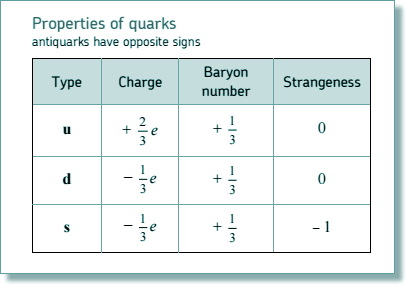Particle Questions that include Feynman Diagrams
Q8. A positron is emitted from a nucleus when a proton changes to a neutron in the nucleus.
The Feynman diagram for the quark interaction is shown in the diagram.

(a) Identify the particles labelled A, B, C and D in the diagram.
A = d (down quark) 

B = w+ 
C and D (either way round) = e+ (positron) and νe 
(3 marks)
(b)
(i) State the interaction responsible for this process.
weak 
(1 mark)
(ii) State which letter in the diagram above represents an exchange particle.
B 
(1 mark)
(iii) State one difference between this exchange particle and a photon.
The w-boson has charge whereas a photon does not have charge. 
The w-boson has (rest) mass but the photon has zero (rest) mass. 
The photon has an infinite range but the range of the w+ boson is much shorter. 
(1 mark)
(c) Energy and momentum have to be conserved in this process.
State two other quantities that need to be conserved and show that they are conserved in the process.
|
u |
→ |
d |
+ |
e+ |
+ |
ve |
|
|
charge  |
+2/3 |
→ |
-1/3 |
+ |
1 |
+ |
0 |
balances |
|
lepton number  |
0 |
→ |
0 |
+ |
-1 |
+ |
+1 |
balances |
|
baryon number  |
+1/3 |
→ |
+1/3 |
+ |
0 |
+ |
0 |
balances |
|
(4 marks)
(Total 10 marks)








